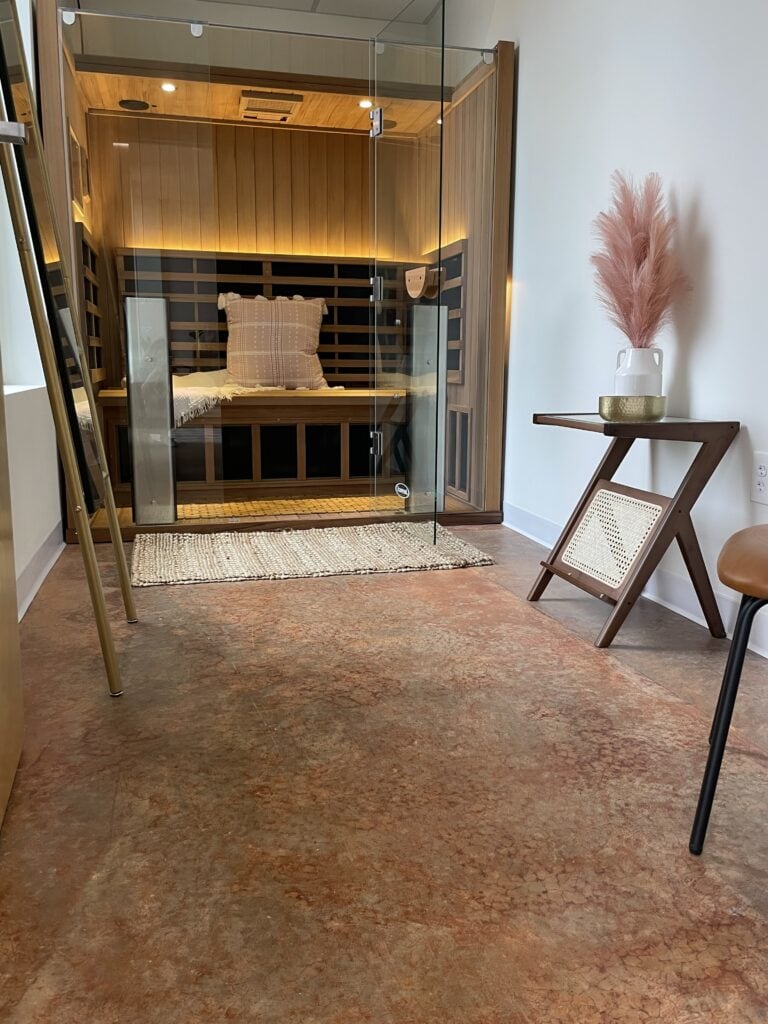
Moving along in our series on holistic wellness offerings and the science behind them, I wanted to focus on one of my favorites: infrared sauna. I know, I know – it’s a sauna outside. Hear me out because these machines aren’t your typical saunas; no, it is not the same thing as walking outside, and they’ll help your body with so much more than a simple detox.
Contrary to popular belief, infrared saunas aren’t (excruciatingly) hot, and there’s no water involved (aside from the gallon or so that you should be drinking every day, anyway). The main difference between infrared saunas and traditional saunas is how they leverage heat. Traditional saunas use a single heater that heats the air which then heats the body. The detoxification benefits (namely through sweating and elevated heart rate) are more like a side effect of your body’s reaction to the extreme conditions. These methods can be hard on the body if experienced for too long or too often. In contrast, infrared saunas offer an innovative light-based therapy that leverages more advanced and targeted technology. Special panels around the sauna distribute full spectrum infrared waves that promote heat generation within the body instead of in the air. Full spectrum means the machine generates near, mid, and far infrared waves – each named for their placement on the total light spectrum. What this means for you is you can sweat for a longer period of time, more days out of the week, and without feeling like you’re gasping for air. It doesn’t stop there, the measured benefits of the infrared waves themselves extend beyond muscle relaxation and sweat:
Near infrared is also responsible for photobiomodulation, used in the medical industry to energize cells and stimulate, heal, regenerate and protect tissue that has either been injured, inflamed, is degenerating, or else is at risk of dying. Near infrared waves are so short that they cannot be captured by the water in your body, allowing them to penetrate the deepest; this is mainly what increases your core thermal energy (i.e., energizing your body and creating heat from the inside out).
Mid infrared waves are long enough to be captured by your body’s water and temporarily increase circulation through vasodilation (i.e., the dilation of blood vessels, which decreases blood pressure), promoting an increase in blood flow, heart rate and — subsequently — your metabolism. For these reasons, mid-infrared waves are largely responsible for the reduction of inflammation in muscles, joints and the vascular system as a whole.
Far infrared is the closest to that which is given off by our own bodies and is readily captured by its water molecules. According to the National Institute of Health, our bodies actually give off far infrared wavelengths at a rate of about 9.4 microns. Studies suggest this is why far infrared waves help with fatigue recovery and an overall feeling of rejuvenation immediately after a session.

There’s evidence that regular infrared sauna use can help you avoid the common cold, reduce oxidative stress (which is associated with cardiovascular disease, cancer and degenerative diseases like dementia) and increase the quality of your sleep. These claims have been validated in small studies or meta-analyses like the one produced by Beever (2009), but research is still in its relative infancy.
Sweating for 45 minutes can really help you shed some water weight, that’s for sure. At the same time, water weight isn’t the only reason you’re feeling sluggish, your back hurts, or your mood is off. We put our bodies through so much, every single day, and must pay attention when they begin telling us to slow down, take a breath, and take care.




Where can I find an infrared sauna in Lake Nona?
Lightly Salted Spa
Here is there address:
10006 Wellness Wy Suite 130, Orlando, FL 32832